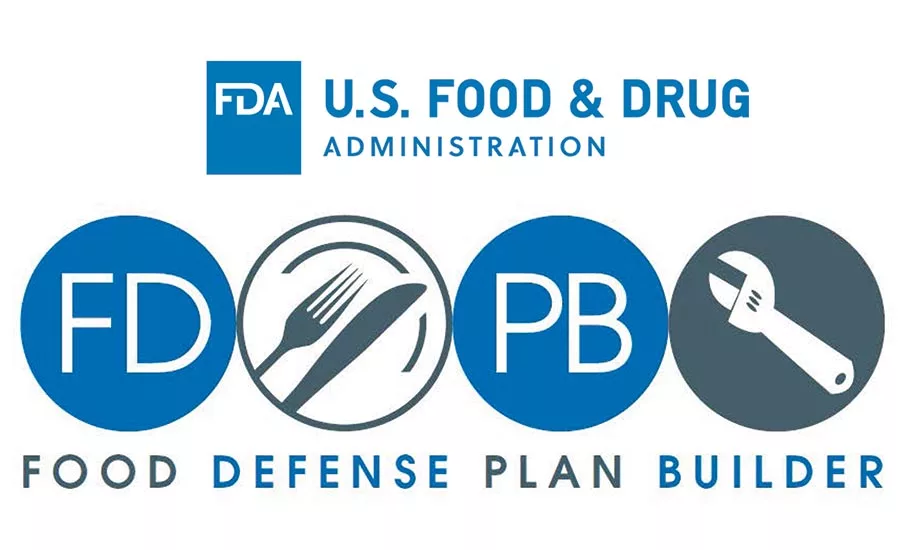Manufacturing News
FDA offers help with food defense plans

FDA’s FDPB Version 2 is a free software application that helps processors set up a complete food defense strategy.
Image courtesy of FDA
For processors that have either put off or need help with building an organized food defense plan, look no further than the FDA’s website.
The FDA launched its Food Defense Plan Builder (FDPB) Version 2.0 software program. The application is a user-friendly tool designed to help owners and operators of food facilities create a detailed food defense plan specific to their facility and products. According to FDA, this tool may assist processors with meeting the requirements of the FSMA Final Rule for Mitigation Strategies to Protect Food Against Intentional Adulteration regulation (21 CFR Part 121) (IA rule). The software is compatible with all Windows 7, 8.1 and 10 personal computers with at least Microsoft .NET Version 4.5 or later installed.
This database-driven tool provides a simple-to-use, fill-in-the-blanks system that—when finished—can generate a complete report that is consistent with FDA’s existing regulations and guidance on food defense. While the finished report that the software generates doesn’t constitute FDA approval of a food defense plan, the tool certainly goes a long way in helping a processor organize, create and document a detailed food defense program and strategy.
Processors need not worry about the software “phoning home,” as FDA doesn’t track or monitor its use, nor does the agency have access to any content or documents saved using the program. A processor’s data created using the program remains on the computer or server to which the FDPB document is stored.
However, in the mitigation strategies section of FDPB, users have the option to access the FDA’s online Food Defense Mitigation Strategies Database and search for ideas and content to incorporate into their food defense plan. By default, this option is turned off but can be turned on for a session and then turned off for later sessions.
A closer look
The software comes with built-in help and a 57-page manual, though many users will find the application easy enough to understand without continuously consulting the manual. The program has eight input buttons or categories (e.g., vulnerability assessments, mitigation strategies, etc.) with a ninth for submitting an electronic signature. Another button, labeled food defense plan, will generate a report at any time during the data entering phase, making it possible to check the progress of the report for correctness and completeness. The report can be printed or exported in Word, Excel and PDF formats. It even has a built-in spellchecker.
The resulting document output can include any or all of the following sections (depending on user selections): facility description; food defense team/individual qualifications; product/process descriptions; vulnerability assessments; mitigation strategies; monitoring, corrective actions and verification procedures; supporting document list; education, training and/or experience documentation list; and an appendix. The supporting document list can handle most file types, such as Word, Excel, Adobe Acrobat, jpg, tif, etc. The document list can also accommodate html locations.
The key point of using this tool is to organize material that might be scattered across a facility in several places—either physical or electronic. The level of detail of the output will be no better than what is put into the system. A key advantage of using this tool is that there is no requirement to sit down and enter all the data at once—as, for example, some online forms require.
The program allows processors to add data as they accumulate it, make changes to it as a process changes, or delete it if it no longer applies—for example, a key food safety team member leaves or comes on board, a product is discontinued, or a change in the plant architecture/structure is made. The tool lets processors drill down with details when necessary; FDA has set up the system to provide as much or little detail as required to complete a report that will adequately describe a processor’s food defense tactics for each ingredient used and product created.
Processors that have used Version 1 can migrate their data to Version 2. Once you make the move, the data will no longer be compatible with Version 1 unless you have saved a backup file, which is always a good idea anyway.
To read more about the Food Defense Plan Builder Version 2, access the instruction manual or download the program, visit FDA’s FDPB webpage—or visit www.fda.gov and search for FDPB.
Looking for a reprint of this article?
From high-res PDFs to custom plaques, order your copy today!






